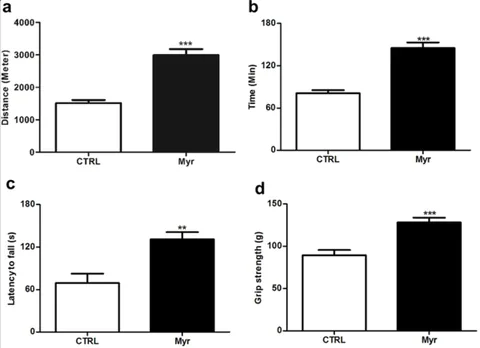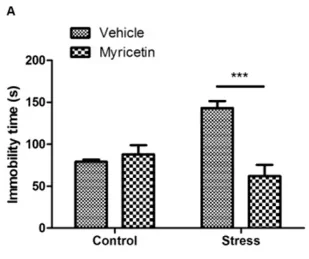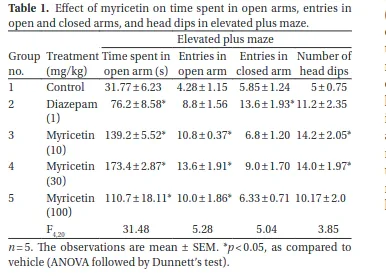This post will look into the many interesting mechanisms of the polyphenol, Myricetin. It is not to be understated, and it transcends most similar polyphenols through being a potent endurance-enhancer and nootropic. Just for reference, this is a repost to this sub, with a few updates for accuracy. Introduction to Myricetin
Myricetin is a natural product found in many plants/fruits, most notably bayberries/strawberries. However, the flavonoid content of foods is extremely variable [1] and is influenced by both location, soil quality, and other factors.
As mentioned, myricetin is prominantly found in bayberry extract [22] alongside other polyphenols (such as myricitrin and quercetin). Consuming bayberry is one way to intake Myricetin, but it requires a high dose, and is combined with many other polyphenols that may increase the cytotoxic potential.
Most people intake only about 20mg of myricetin per day through diet (on average) [6], while the performance-enhancing/nootropic doses are about 10-20x higher. Myricetin's oral bioavailability is only about 10%, meaning dosages required for pychoactive/enhancing effects range between 250-600mg [2].
Most polyphenols/flavonoids are pretty weak in terms of efficacy, however myricetin stands out from the rest in multiple ways. It's most notable effects are that it enhances physical endurance, is a potent antidepressant, and directly inhibits SARS-COV-2 and HIV.
Performance-Enhancing Effects of Myricetin 

Myricetin is a potent endurance enhancer, doubling physical endurance in rodents after 4 weeks (in multiple studies) [17][18] at the human equivilant dose of 250-300mg. This effect is mediated through multiple mechanisms, however Myricetin does this most notabley through increasing the expression of the following (directly/indirectly) in muscle fiber: PGC-1b, PGC-1α, ERRa, PPAR-a/b/d/γ, Sirt1, Foxo1, and more.
Myricetin most notably enhances PGC-1b, which is associated with performance in endurance athletes [15], and is associated with endurance in animal models [16]. Myricetin also promotes the conversion of fast-to-slow twitch fiber in muscle [18], and this would create an expected increase in endurance and decrease in strength. However, in the studies provided, Myricetin enhanced grip strength in mice, showing a modest strength-enhancing capability of the compound on top of endurance enhancement.
Myricetin also enhances GLP-1 [26], which means it is likely an exercise mimetic through it and also it is likely to induce some degree of fat loss as seen with other GLP-1 agonists.
Antidepressant Effect 

In multiple studies, myricetin ameriolated symptoms of depression and increased stress resilience [19]. This antidepressant effect has also been seen in anecdotal reports using the pure powder form of this compound. This is potentially through anti-inflammitory effects, CAMKII/BDNF/NGF/TrkB/COMT modulation, or other mechanisms.
Myricetin is also a MAO inhibitor, but seems to be less potent than quercetin in that regard [#27], so most of its antidepressant effects may be due to other mechanisms.
In one study [19], chronic administration of myricetin restored hippocampal BDNF protein levels in mice subjected to repeated restraint stress.
Anxiolytic & Anti-PTSD Effect 
Myricetin exerts antidepressant and anxiolytic effects through regulation of HPA axis and activation of the BDNF-ERK signaling pathway [20].
Myricetin inhibits stress-induced changes in 5-HT, BDNF, TrkB, NE, ACTH and more. It has been shown to be most anxiolytic at the human equivilant dose of 200-300mg, with a slightly lower efficacy at 500mg equivilant human dose. [21]
In multiple studies, myricetin ameriolated symptoms of depression and increased stress resilience [19]. This antidepressant effect has also been seen in anecdotal reports using the pure powder form of this compound. This is potentially through anti-inflammitory effects, CAMKII/BDNF/NGF/TrkB/COMT modulation, or other mechanisms.
Myricetin is also a MAO inhibitor, but seems to be less potent than quercetin in that regard [#27], so most of its antidepressant effects may be due to other mechanisms.
In one study [19], chronic administration of myricetin restored hippocampal BDNF protein levels in mice subjected to repeated restraint stress.
Anxiolytic & Anti-PTSD Effect 
Myricetin exerts antidepressant and anxiolytic effects through regulation of HPA axis and activation of the BDNF-ERK signaling pathway [20].
Myricetin inhibits stress-induced changes in 5-HT, BDNF, TrkB, NE, ACTH and more. It has been shown to be most anxiolytic at the human equivilant dose of 200-300mg, with a slightly lower efficacy at 500mg equivilant human dose. [21]

Protective Effect in Alzheimer's/Parkinson's Disease 
Myricetin improved learning and memory in rodent models of Alzheimer's. It reduced oxidative stress, inhibited AChE, decreased iron accumulation, and suppressed Aβ aggregation. It also has protective mechanisms through increased phosphorylation of CREB, a transcription factor that regulates BDNF and NGF expression. [2][4]. Myricetin also reversed motor deficits and dopamine depletion in Parkinson's models. It suppressed oxidative stress, prevented α-synuclein aggregation, and inhibited iron accumulation. Mechanisms involve tyrosine hydroxylase, BDNF, and COMT inhibition (which is almost exclusively located in the PFC, meaning inhibition enhances PFC function [10]) [2][5].
Protective Effect in Epilepsy 
Myricetin reduced seizure rates in a mouse model, potentially by enhancing GABA-A activity (contextually) and inhibiting MMP-9. It activated CaMKII signaling and potassium currents to calm hypothalamic PVN neurons [8].
Protective Against CVD 
Myricetin exhibits cardioprotective, anti-hypertensive, anti-atherosclerotic, anti-hyperglycemic, and anti-hyperlipidemic effects. In addition, myricetin may alleviate some of the complications caused by adult-onset diabetes. The combined functions of myricetin allow for the prevention of CVD [9].
Oxidant Interactions 
Myricetin can act as a pro-oxidant compound when it interacts with DNA [6]. Studies involving in vitro models have shown that myricetin causes the degradation of DNA. This may make myricetin seem bad at a glance, however at higher and higher concentrations of myricetin, the rate of DNA damage has been shown to decrease [7]. Therefore, adding additional myricetin through supplementation would actully reduce existing pro-oxidation caused through low-quantity myricetin intake through standard diets. Myricetin is also anti-inflammatory through its ability to inhibit the amplified production of cytokines that occurs during inflammation.
Antidiabetic Effect 
Several in vitro and animal studies have indicated the antidiabetic capabilities of myricetin [6], however, myricetin's close relative myricitrin seems to have a larger potential for anti-diabetic actions, showing as effective (and even more effective) as metformin, with less side effects [11].
Protective Against COVID-19 / Antiviral 
Myricetin inhibits the viral replication of SARS-COV-2 [12][13], with very potent inhibitory effects shown in multiple studies. It does this through binding directly to SARS-COV-2, through targeting Mpro. Myricetin was identified to have potent inhibitory activity with an IC50 of 3.684μM in the enzyme assay [13].
Using Myricetin, alongside GCP-II/KAT-II inhibition, currently seems like the best way to ameriolate COVID-19 symptoms, through the literature currently available.
Myricetin also inhibits other viruses, including HIV [14], which has been shown in multiple studies using rodent models.
ROA For Best Metabolism 
The best hypothetical Route of Administration based on literature available is 250-600mg early in the morning on an empty stomach. This is probably the best ROA as myricetin does seem to have some interaction with liver enzymes, meaning food or drink could potentially effect metabolism.
Discussion 
Myricetin has a lot of different beneficial effects, and it is definitely an interesting compound to say the least. It has proven effective in preliminary human testing, especially for its antidepressant and pro-endurance effects.